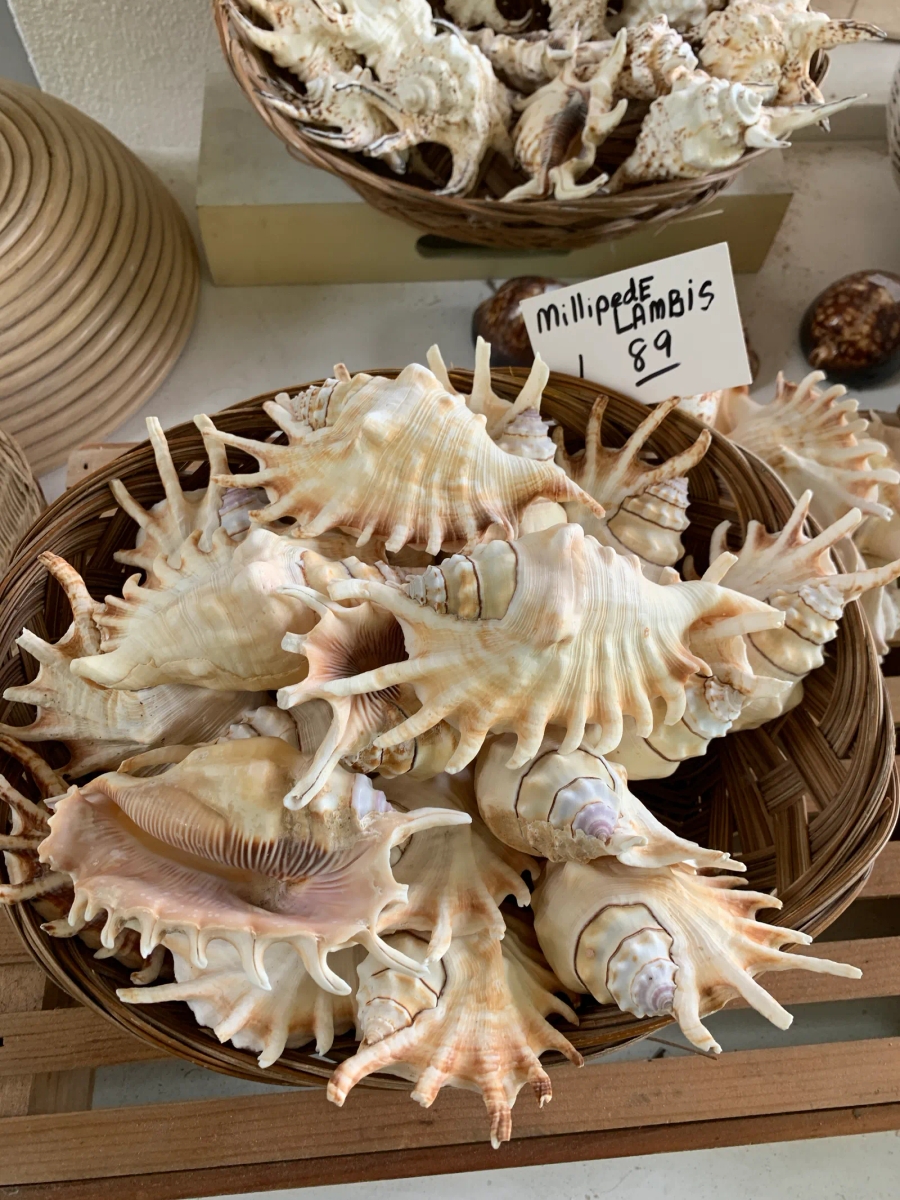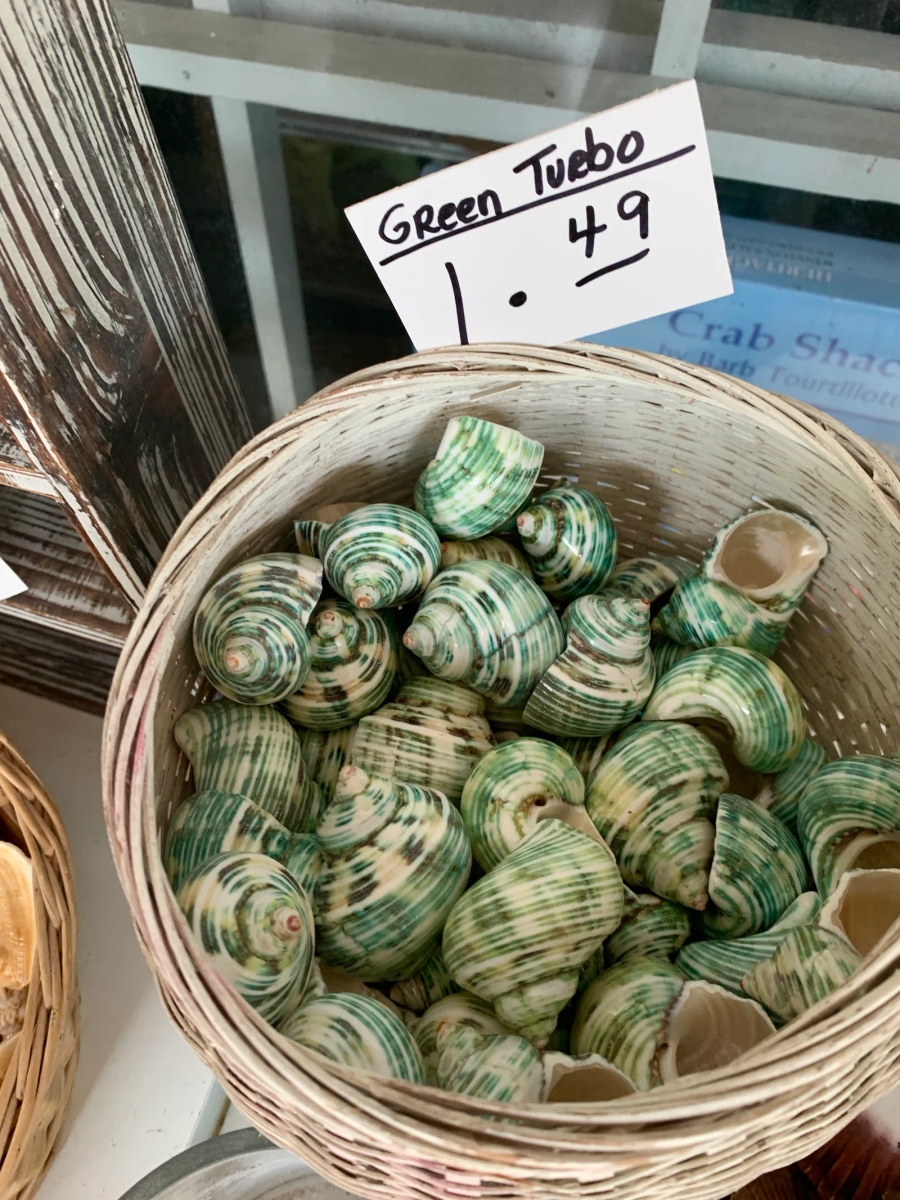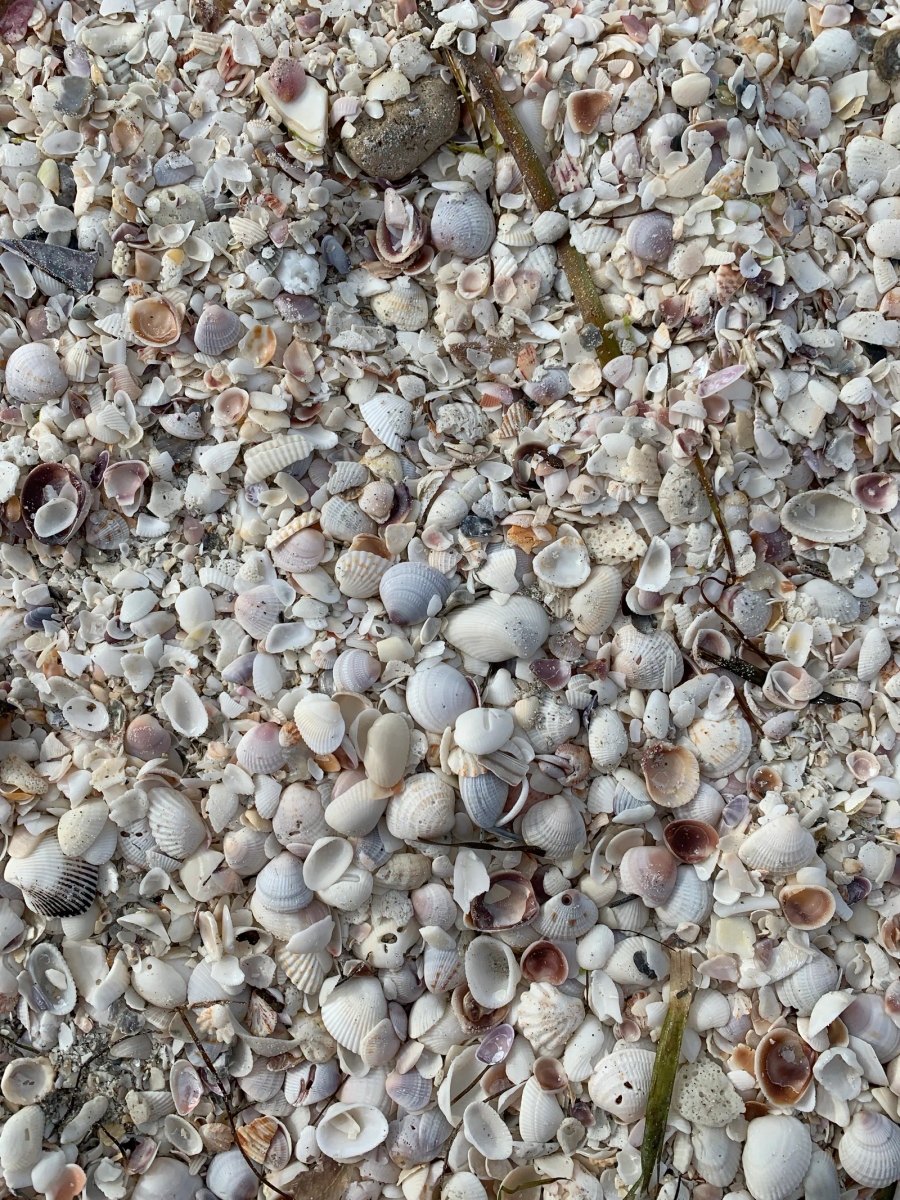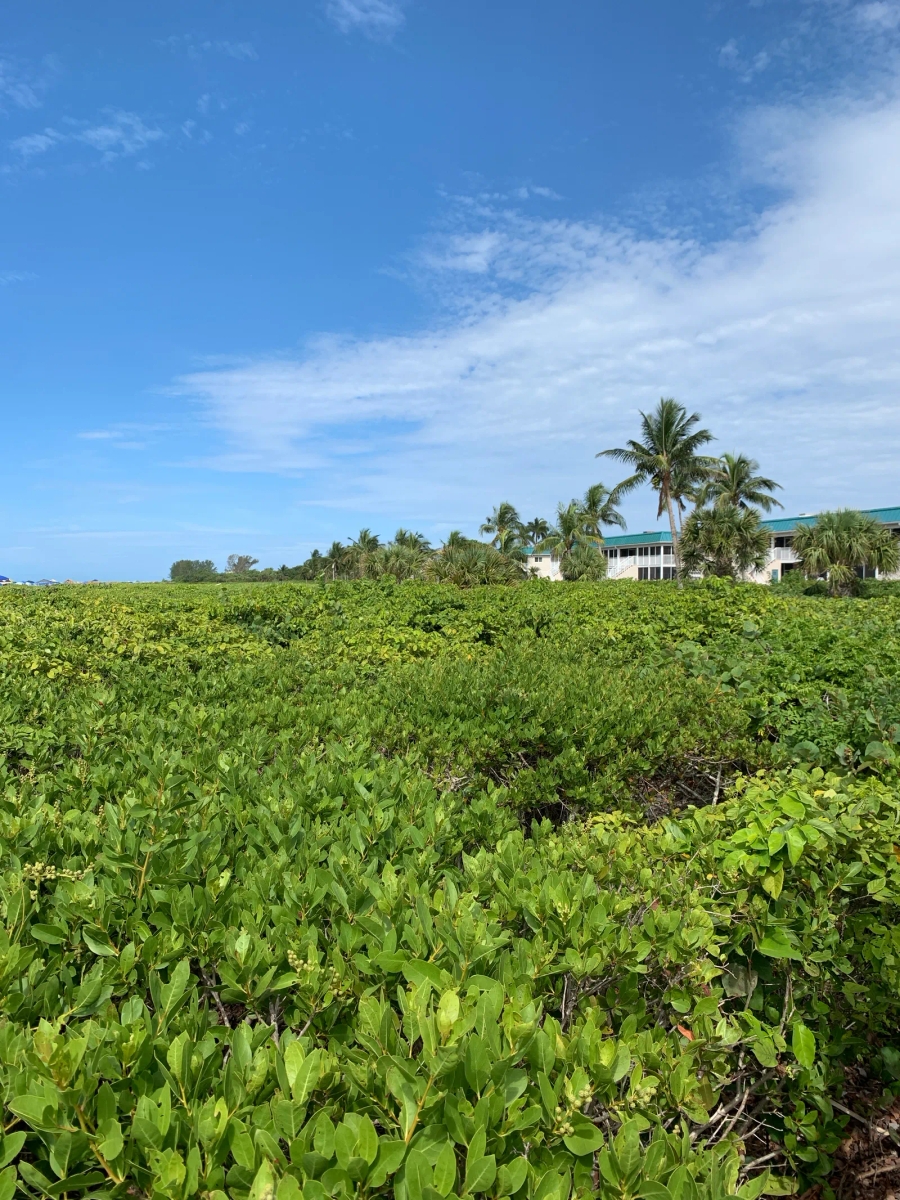On Florida’s Sanibel Island, Shells are an Eternal Muse †
Vogue
2022
I had never seen a conference of seashells before, but there it was, plain as anything, just before the sun descended on a Wednesday evening last June. Six scalloped, bivalve shells consorted wordlessly beneath a tiny makeshift pergola, its posts and trelliswork wrought from twigs. Abandoned by the invertebrates they’d once protected, the shells still appeared to be thoroughly alive, outfitted in dirty creams and plummy rouges. As I took a quick photograph, careful not to interrupt, I admired the site their anonymous orchestrator had selected: a mostly unpeopled section of beach, protected from winds by mounds of lime-green shrubbery.
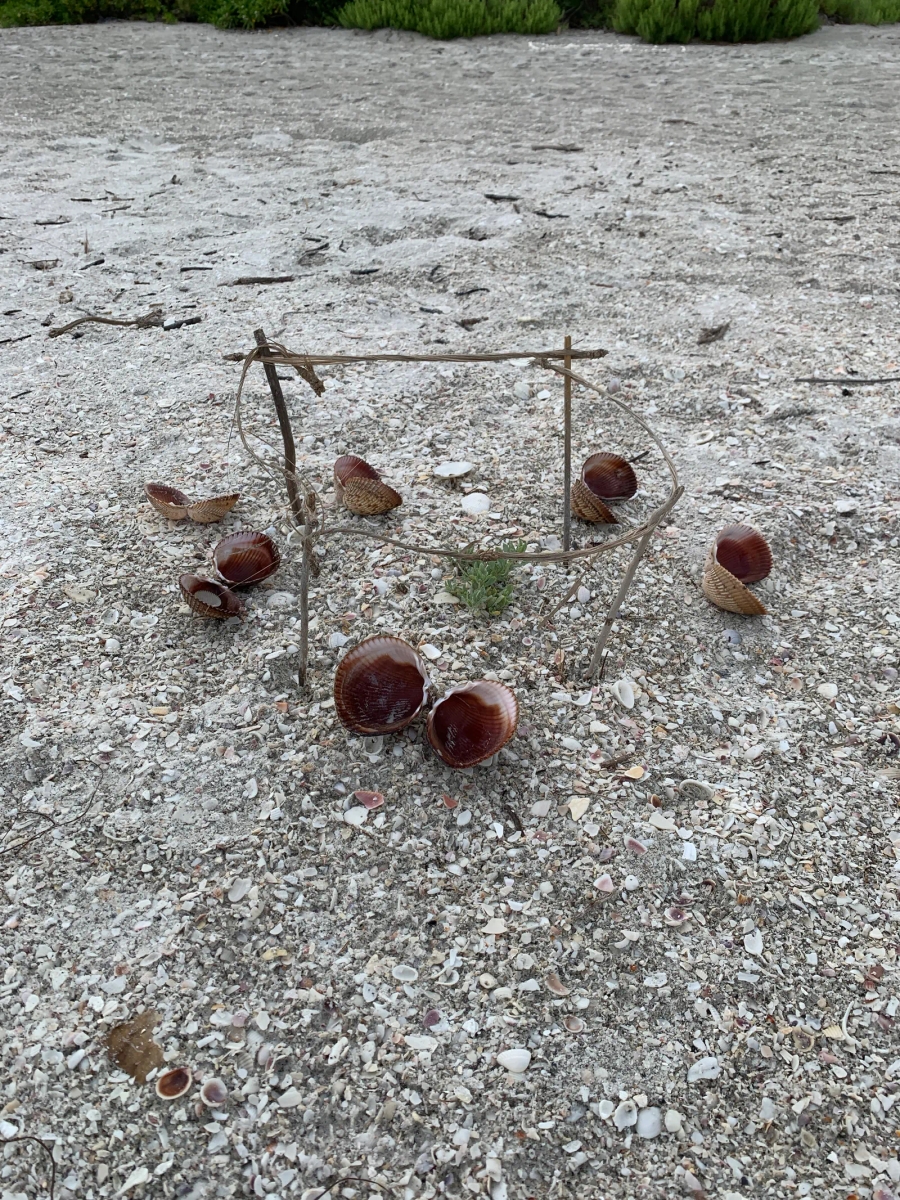
Photo by Laura Bannister.
It is not unusual to personify the exoskeletons of mollusks. Like clouds, shells seem to activate an alternate awareness in us, training our brains to find visual metaphors. Growing up along Australia’s southeastern coast, I’ve long combed beaches for unbroken mollusk and gastropod shells that resemble forms I know: cartoon brains, fingernails, the double curve of buttocks, pointed canine teeth. In his book The Object Stares Back, art critic James Elkins claims this visual foraging is natural, indicative of a deep primordial search for wholeness and for human bodies in particular—our dopplegangers, reflections, refractions, twins. “We instinctively repair fragments into wholes and search for continuous contours and closed curves. Shards present our eyes with a problem, and unwittingly we cast around for patterns, assembling pieces into shapes…When we do not have bodies in front of us, we hallucinate them.”
That scene of beach detritus—the conference of shells—lodged itself in my brain. It was oddly sweet and totally pointless, arranged with humor and care. I’d spied it during a stay in Sanibel, a verdurous, tropical island off the gulf coast of Southwest Florida, where I spent a few weeks writing alone last year, burnt out and desperate to swim. On arrival, I noted the tables in my AirBnB featured bowls of bulk-bought, gleaming seashells. Sand dollars were framed on the walls. Along the low, suburban streets, mailboxes were covered with white shells, laid in kitschy patterns by hand.
Sanibel happens to be North America’s unofficial seashell capital. It’s home to the Bailey-Matthews National Shell Museum, the world’s only reference center devoted to the study of conchology (mollusk shells) and malacology (mollusks themselves), and to more than 250 species of seashells, including buttercup lucines, rare spotted junonias, spiky lace murex and Tampa drills. When it formed around 6,000 years ago, Sanibel and its neighbor, Captiva, were joined as one landmass; now the isles are connected via causeway, and even the causeway has its own shell-abundant beaches. Both islands are barrier islands, meaning they have sandy plateaus—Sanibel’s extends for miles into the Gulf of Mexico. These function as natural shelves for shells, magnets they can cling to for a while before they wash up, emptied, on shore. Because of the tropical climate, Sanibel’s mollusks tend to be bigger and more intensely hued.
Live shelling is illegal on Sanibel, though the predatory marine curio trade—from which many shell-adorned souvenirs spring—explodes elsewhere, and very likely seeps into the island’s gift shops, which are curated wholly around the calcified forms and the notion of nature as ornament. (As a kid, I recall near-identical queen conch shells resting upon both my parents’ and grandparents’ bathroom vanities.) Browsing, I surveyed frothy white Florida spindle shells shaped like baroque torpedoes; cowries painted with the signs of the zodiac or printed with the Lord’s Prayer. There were heaps of slate-colored Sanibel shark eyes sold for 99 cents; lambis chiagras, at $7.95, with six long, curved protrusions reminiscent of Ganesha; shells strung into gaudy wind chimes or whittled into nightlights; and trays crammed with competing sculptural marvels, some jagged and slightly menacing, others pink and paper-thin, some lustrous and pale as pearls.
Outside at low tide, on the isle’s white sand beaches, tourists and residents alike sought out shells for free. Everyone was bent in just the way I’d read they would be, a position local papers dubbed the “Sanibel Stoop.” Their bodies were folded at the waist, arms swinging to skim the ocean’s wetness, plastic buckets and netted bags hanging off wrists. Some evenings, it seemed like the whole beach had left their Tommy Bahama chairs to pan for gold.
Soon enough, I joined them, setting myself new tasks each day: Find shells that are identically shaped, in increasing sizes, and stack them in your palm as though salty babushkas. Find a cone shell that echoes a cake icing pen. Find something inky black. At Lighthouse Beach, on Sanibel’s southern tip, I swam out as far as I could before plunging deep, feeling blindly for a hardened prize. My thumb finally tapped the corner of a shell with knobbly butter-knife serrations along its side. There was nothing in it—invertebrates tend to die inside their shells, leaving their soft parts to decompose or be eaten, with any remnants rinsed clean by the time they wash ashore. Part of the attraction, for me at least, was knowing I could not collect every former carapace, that most were only mine to hold for a moment. I swam through the tepid water like I’d done as a kid, clutching secret jewels of calcium carbonate in one hand. I was witness to the ghostly existence of some long-perished animal, reawakened to my relative smallness in the world. When I reached the shore, I’d drop the remains back into the blue, ready to spot others in the sand.
Evidence of humanity’s attraction to seashells—as both object and decorative motif—traces to prehistoric times. Shells appear strung on necklaces, far inland, in Stone Age graves in France; dotted through tombs of Egyptian Pharaohs; as decoration on ritual masks and clothing; as sturdy bowls, scraping tools and occasional blades; as a key currency (cowry shell money) used in trade networks throughout Africa, South Asia and East Asia; and as wind instruments (cut a hole in the spire of a gigantic triton shell and it morphs into a trumpet). Removed from their marine context and displayed in domestic settings, especially away from coasts, the seashell shifts in perceived value. No longer anonymous, available en masse, the salvaged shell implies a certain preciousness. It was selected, and its selection alludes to an idyllic state of leisure, to a person having the time and space to walk languidly along a stretch of sand and consider their surroundings.
As I watched the frenzied delight of shell hunters on Sanibel and bent down alongside them, scanning hopefully for unusual shapes, I was reminded of the conchylomania (deriving from the Latin concha, or “shellfish”) that swept the Netherlands and beyond in the 18th century, during the Dutch Golden Age. Like the tulip mania of the century prior—one of the first recorded speculative bubbles—the amassing of exotic rarities and “new” species of shell was considered a sage investment in colonizing nations. Not only a marker of vast private wealth, the practice implied intellectual curiosity, a drive to catalog and impose order on a supposedly disordered world. One shell, the earliest recorded specimen of a carinaria cristata, from the collection of Dutch naturalist Pièrre Lyonnet, sold at auction in 1796 for 299 guilders, exceeding its weight in gold.
Nearby, in 17th and 18th century England, conchylomania crystallized into greedier, more flamboyant forms, preempting the all-over crafty flounce of Victorian shell souvenirs. The “shell grotto” was an architectural folly within the country homes of wealthy aristocrats, designed to enhance dank subterranean passages with swirling rococo motifs, mosaics, and Greek columns, every inch carpeted in local and imported shells. As the style developed, grottoes morphed into standalone pavilions, with more naturalistic, arbitrary designs recalling fictitious sea caves. One of the biggest underground grottoes, discovered in Margate, Kent around 1835 and built who knows when (seriously, it’s still a mystery), is estimated to feature 4.6 million shells—husks of local mussels, whelks, limpets and oysters. The excessive dazzle of these spaces belies a desperation to keep alien beauty close, as though its enigmatic charms might rub off on us.
Years ago, I traveled with an old friend to Folegandros, a small, anhydrous island in the southern part of the Cyclades. Its three village settlements comprise around 650 residents—300 in the winter, when the Athenian tourist workers empty out, and the rough Meltemi winds turn to screams. When we docked at summer’s end, shells jangled in my pockets like laundromat quarters. I’d begun stockpiling them with a doomsday prepper’s enthusiasm on the neighboring island, Paros. I bought a €20 shell lamp so large I had to mail it back to New York, bubble-wrapping its tendrilled protrusions. I found an abandoned tiger cowrie—once home to a carnivorous sea snail—that was smooth and cool and comforting to hold. Walking around, I’d press the opening to my ear, listening as my surroundings resonated in its cavity.
We ended up stuck on the island for a while. The weather turned—a result of two pressure systems colliding—and the Aegean was too rough for boats to run. Our final days became a closed loop: take the local bus to a sheltered beach, then to a wind-battered village. Split a bowl of Matsata pasta in the evening plus cheap wine and cans of coke. I can’t recall many other details, really—an image of splashing children who looked like seraphim, golden and beatific; my friend and I arguing about reality TV. Everything else has melted together, a blinding wall of white stucco and blue. What I do remember, with great affection and specificity, were small exchanges on the beach. We’d find tiny shells for one another, searching between swims, and offer them up with outstretched palms, a sign we understood a little of the other’s gaze. I can’t remember if we kept any, but that wasn’t the point. The point was a small marvel, shared.
vogue.com/article/on-floridas-sanibel-island-shells-are-an-eternal-muse
